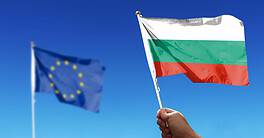EMERGING MARKETS REGIONAL REVIEW
 While Central Europe appears to be recovering from the effects of the global economic downturn, Southeastern Europe is in for a rougher ride.
While Central Europe appears to be recovering from the effects of the global economic downturn, Southeastern Europe is in for a rougher ride.
Just how badly was emerging Europe hit by the global economic downturn? The latest IMF survey on Central & Eastern Europe suggests the region as a whole over the past five years grew by precisely one-tenth of what had been expected prior to the collapse of Lehman Brothers—0.5% a year instead of 5%. Owing to a combination of a collapse in local demand and exports and contagion from the eurozone crisis, CEE countries have seen unemployment accelerate, fiscal imbalances develop and persist and foreign direct investment—which was the driver of growth in most of the countries—slump.
As a consequence, economic convergence with Western Europe has slowed and in some cases reversed. “We now see convergence as something that will still happen going forward but at a slower pace, and that pace will depend on the policies followed,” James Roaf, the IMF’s regional resident representative for Central & Eastern Europe, stated in October after the survey’s publication.
Despite this divergence, the good news for CEE is that its downturn—the second in five years—now seems at an end. Although few countries will match the Baltics for growth, GDP is expanding and will accelerate further next year, led by Poland and Slovakia. “Momentum across the region is building, most economic indicators are good and still improving—barring a resumption of the euro crisis, which could yet impact on Central Europe’s prospects, we expect good, solid growth,” says Neil Shearing, chief emerging markets economist at London-based consultancy Capital Economics.
A POLISH-LED RECOVERY
Shearing expects CEE’s recovery to be led by Poland, which after a disappointing 2012 has seen its economy pick up: Industrial production is growing by just under 5% year-on-year, one reason why Capital Economics’ growth forecast for 2013 is above consensus at 3%. Another reason is that confidence has returned, as demonstrated by local equity markets. During October the MSCI Eastern Europe Index grew by 3.3%, against 1.3% for the MSCI Emerging Markets Index, and for the year, the former is outperforming all other emerging markets indexes.
“Investors and corporates are buying into the idea of an EU recovery, and CEE has been a big beneficiary of this,” argues Charlie Robertson, global chief economist at Renaissance Capital, an investment bank focused on the region. He says other positives about the region—including wage levels that are still a fraction of those prevailing in the EU’s recession-hit southern tier and productivity levels that are in many cases higher—are also playing in CEE’s favor.
That is not to say the region is without its problems. Although Hungary’s economy is finally recovering, fears remain about the business environment. Prime minister Viktor Orbán recently suggested the country’s energy sector should be reorganized along not-for-profit lines to benefit hard-hit consumers. The huge buying power of Poland’s pension funds has, in the view of many, made Poland’s equity market too pricey. Meanwhile, talk of new taxes on Czech power utility CEZ and Komerní banka—the two largest entities on the Prague Stock Exchange—has hit Czech confidence, as has uncertainty following the October 26 election, which failed to produce a clear winner. But the overall sense is that things in Central and Eastern Europe are moving in the right direction.
IMBALANCES PERSIST IN THE SOUTH
The same thing cannot be said about Southeastern Europe. Where recovery can be found, it is at best uncertain. Many SEE countries face economic imbalances and persistent high unemployment as well as a range of political and other problems that are constraining investors and depressing growth.
 |
|
Sanfey, EBRD: SEE countries did not undertake as much reform as we thought they did |
The fact that many of these countries have strong economic ties to the EU’s depressed southern tier—notably Italy and Greece—rather than to booming Germany, like the CEE countries, is also problematic. And despite the two Vienna Initiatives set up by international financial authorities to prevent an outflow of Western capital from emerging European banks, questions hang over Southeastern Europe’s banking sector.
In Bulgaria, Greek banks remain the largest investor; in Romania, Serbia and other, smaller countries, they represent a major presence. Doubts also persist about Slovenia’s banks. The results of stress tests in November will determine whether the sector—indeed whether the whole country—gets the bailout that many say is desperately needed.
“The fact Slovenia’s central bank commissioned the more extensive tests recommended by the EU in August indicates tacit agreement that problems in the banking sector may be bigger than currently portrayed,” suggests Mujtaba Rahman, head of European analysis at the Eurasia Group consultancy.
Peter Sanfey, lead economist for the SEE region at the European Bank for Reconstruction and Development (EBRD), says Slovenia is essentially stuck in transition. “Countries did not undertake as much reform as we thought they did: They failed to put in buffers when their economies were growing and are now spending a lot of time fire-fighting,” he says.
ETERNAL STRIFE
Although banks are generally well-capitalized and liquid, nonperforming loan ratios are around 20% in Serbia and Albania and 17% in Bulgaria. As a result of all these factors, the EBRD is set to lower its SEE growth forecast for the year to around 1% against the 1.4% it projected in May.
Among countries that should do better is Romania, which after months of political wrangling seems to have at least got its fiscal house in order—the deficit this year should be close to 3% against 9% four years ago. A new loan agreement with the IMF for $2 billion, agreed upon in the wake of the successful completion of the previous one, should boost investor confidence that Bucharest is serious about economic reform. Neighboring Bulgaria, by contrast, seems locked in eternal strife, with an unstable coalition unable to move forward with reform or do much to boost growth from last year’s 0.8%:This year GDP will increase by 0.9% at best. Croatia is expected to record another year of negative growth—the fifth year in a row. Hopes are higher for Serbia: A dynamic young finance minister, rising exports and the expectation that in January it will open negotiations to join the EU are all positives.
A six-point plan to overhaul the economy by, among other things, reducing subsidies and public-sector salaries and increasing the value-added tax have persuaded observers that Belgrade is on the right path, but because of the squeeze on salaries and subsidies, GDP growth this year and next will probably not be much more than 1.5%.
Both the IMF and the EBRD say the only way the countries of SEE can move forward is to get serious about reform. The IMF says the countries need to address crisis legacies including reducing obstacles to tackling nonperforming loans, improving the investment environment, boosting the tradable sector and ensuring a well-functioning labor market. The areas the EBRD singles out for attention are health, education, pensions and public administration/governance. “Substantial reforms can generate a growth dividend worth about 1% of GDP a year,” says Sanfey. SEE countries—places that have essentially slipped off the investor radar—need something else: high-profile good news to restore investor appetite. In the short term at least, the chances of this happening look slim.



